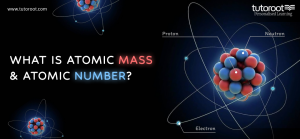What is Atomic Mass and Atomic Number? – Definition, Mass for 30 Elements
Atomic mass is the average mass of an element’s atoms measured in atomic mass units (AMU). The atomic mass is the average weight of all isotopes present in an element. The molar mass of each isotope is multiplied by its abundance. It’s worth noting that it is also referred to as atomic weight. In this article let’s study the nuclear mass of elements in detail, along with the atomic number and atomic mass of elements.
What is the Atomic Mass of an Element?
A single atom’s atomic mass is its absolute mass, and it is commonly given in atomic mass units (AMU). For example, a Nitrogen atom with seven neutrons and seven protons have an atomic mass of 14 AMU. Generally, the atomic mass number is rounded to the nearest whole number.

Because an element’s isotopes have different atomic weights, researchers may also determine the element’s overall atomic mass (also known as the atomic weight). The general atomic mass is the average of the atomic masses of many different isotopes. This makes it a useful value to know when working with elements that have multiple isotopes. The contribution of each isotope to the normal is determined by how large a proportion of the example it makes up. The overall atomic masses presented in periodic tables, such as the one for Nitrogen, are derived for each element’s naturally occurring isotopes, weighted by the weight of those particular isotopes on Earth.
What is the Atomic Number?
The atomic number indicates how many protons are contained within the atom’s nucleus. Regardless of the number of neutrons present, elements are identified based on the number of protons in the nucleus. Neutrons are uncharged subatomic particles that, when bonded in an atomic nucleus, are stable. Except for hydrogen, all atoms contain neutrons in their nucleus.
The atomic number is significant because it affects the number of electrons that surround the nucleus. The number of electrons in an element significantly influences its chemical behavior.
When looking at the periodic chart, one can observe that elements are ordered by increasing atomic numbers. Elements with comparable properties are assigned to the same column or group. Group 1A elements, for example, are largely soft metals that are strongly reactive to water. Similarly, at room temperature, the elements of Group 8A are unreactive gaseous. A periodic repeating of attributes may be found in the elements with increasing mass in the same group.
| Atomic Number | Element | Atomic Mass |
| 1 | Hydrogen | 1.008 |
| 2 | Helium | 4.0026 |
| 3 | Lithium | 6.94 |
| 4 | Beryllium | 9.0122 |
| 5 | Boron | 10.81 |
| 6 | Carbon | 12.011 |
| 7 | Nitrogen | 14.007 |
| 8 | Oxygen | 15.999 |
| 9 | Fluorine | 18.998 |
| 10 | Neon | 20.18 |
| 11 | Sodium | 22.99 |
| 12 | Magnesium | 24.305 |
| 13 | Aluminium | 26.982 |
| 14 | Silicon | 28.085 |
| 15 | Phosphorus | 30.974 |
| 16 | Sulfur | 32.06 |
| 17 | Chlorine | 35.45 |
| 18 | Argon | 39.948 |
| 19 | Potassium | 39.098 |
| 20 | Calcium | 40.078 |
| 21 | Scandium | 44.956 |
| 22 | Titanium | 47.867 |
| 23 | Vanadium | 50.942 |
| 24 | Chromium | 51.996 |
| 25 | Manganese | 54.938 |
| 26 | Iron | 55.845 |
| 27 | Cobalt | 58.933 |
| 28 | Nickel | 58.693 |
| 29 | Copper | 63.546 |
| 30 | Zinc | 65.38 |
Differences: Atomic Number and the Atomic Mass of Elements
Let us now examine the distinction between the atomic number and atomic mass of elements.
| Atomic Mass | Atomic Number |
| Atomic mass is relative to the number of neutrons and protons contained in an element’s nucleus. | The number of protons in an element’s nucleus is referred to as its atomic number. |
| The average weight of a specific element. | It is the total number of nucleons in the nucleus of an atom. |
| Denoted by A | Denoted by Z |
| Atomic mass cannot be used to determine the element type. | Atomic numbers are commonly used to categorize and identify elements. |
| Atomic mass is also used to differentiate between various isotopes of the same element. | Isotopes in elements have the same atomic number. |
| The atomic mass unit is always used to measure atomic mass (AMU). | The atomic number is just a digit used to organize atoms in the periodic table. |
Final Notes
This concludes our discussion on atomic mass and number. We hope this has helped you develop a better understanding of the concept. If you still have any doubts, you can join the live interactive classes offered by Tutoroot. The Chemistry faculty are always open to clarify your doubts.
